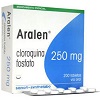 Pill Categories
Pill Categories
Aralen
 |
Chloroquine is used to treat and to prevent malaria. Chloroquine is also used to treat infections caused by amoebae. |
PRODUCT DESCRIPTION, SAFETY, ETC View product image
Aralen 500 mg
Aralen 250 mg

PRODUCT DESCRIPTION
DRUG TITLE
Chloroquine (Aralen)
INDICATIONS
Chloroquine is indicated for the suppressive treatment and for acute attacks of malaria due to P. vivax, P.malariae, P. ovale, and susceptible strains of P. falciparum. The drug is also indicated for the treatment of extraintestinal amebiasis.
INSTRUCTIONS
Take chloroquine with meals or milk to lessen stomach upset, unless otherwise directed by your doctor.
It is very important that you take chloroquine only as directed. Do not take more of it, do not take it more often, and do not take it for a longer time than your doctor ordered. To do so may increase the chance of serious side effects.
If you are taking chloroquine to help keep you from getting malaria, keep taking it for the full time of treatment. If you already have malaria, you should still keep taking chloroquine for the full time of treatment even if you begin to feel better after a few days. This will help to clear up your infection completely. If you stop taking chloroquine too soon, your symptoms may return.
Chloroquine works best when you take it on a regular schedule. For example, if you are to take it once a week to prevent malaria, it is best to take it on the same day each week. Or if you are to take two doses a day, one dose may be taken with breakfast and the other with the evening meal. Make sure that you do not miss any doses. If you have any questions about this, check with your health care professional.
If you miss a dose of chloroquine, take it as soon as possible. However, if it is almost time for your next dose, skip the missed dose and go back to your regular dosing schedule. Do not double doses.
DOSAGE
The dosage of chloroquine phosphate is often expressed in terms of equivalent chloroquine base. Each 500 mg tablet of ARALEN contains the equivalent of 300 mg chloroquine base. In infants and children the dosage is preferably calculated by body weight.
Malaria: Suppression - Adult Dose: 500 mg (= 300 mg base) on exactly the same day of each week.
Pediatric Dose: The weekly suppressive dosage is 5 mg calculated as base, per kg of body weight, but should not exceed the adult dose regardless of weight.
If circumstances permit, suppressive therapy should begin two weeks prior to exposure. However, failing this in adults, an initial double (loading) dose of 1 g (= 600 mg base), or in children 10 mg base/kg may be taken in two divided doses, six hours apart. The suppressive therapy should be continued for eight weeks after leaving the endemic area.
For Treatment of Acute Attack.
Adults: An initial dose of 1 g (= 600 mg base) followed by an additional 500 mg (= 300 mg base) after six to eight hours and a single dose of 500 mg (= 300 mg base) on each of two consecutive days. This represents a total dose of 2.5 g chloroquine phosphate or 1.5 g base in three days.
The dosage for adults of low body weight and for infants and children should be determined as follows:
First dose: 10 mg base per kg (but not exceeding a single dose of 600 mg base).
Second dose: (6 hours after first dose) 5 mg base per kg (but not exceeding a single dose of 300 mg base).
Third dose: (24 hours after first dose) 5 mg base per kg.
Fourth dose: (36 hours after first dose) 5 mg base per kg.
For radical cure of vivax and malariae malaria concomitant therapy with an 8-aminoquinoline compound is necessary.
Extraintestinal Amebiasis: Adults,1 g (600 mg base) daily for two days, followed by 500 mg (300 mg base) daily for at least two to three weeks. Treatment is usually combined with an effective intestinal amebicide.
STORAGE
Store the medicine in a closed container at room temperature, away from heat, moisture, and direct light. Keep from freezing.
Keep out of the reach of children.
Do not keep outdated medicine or medicine no longer needed.
Safety Information
If you will be taking chloroquine for a long time, it is very important that your doctor check you at regular visits for any blood problems or muscle weakness that may be caused by chloroquine. In addition, check with your doctor immediately if blurred vision, difficulty in reading, or any other change in vision occurs during or after treatment. Your doctor may want you to have your eyes checked by an ophthalmologist (eye doctor).
If your symptoms do not improve within a few days or if they become worse, check with your doctor.
Make sure you know how you react to chloroquine before you drive, use machines, or do anything else that could be dangerous if you are not able to see well.
Chloroquine may cause blurred vision, difficulty in reading, or other change in vision. It may also cause some people to become lightheaded.
If these reactions are especially bothersome, check with your doctor.
Certain medicines should not be used at or around the time of eating food or eating certain types of food since interactions may occur. Using alcohol or tobacco with certain medicines may also cause interactions to occur. Discuss with your healthcare professional the use of your medicine with food, alcohol, or tobacco.
There are no adequate and well-controlled studies evaluating the safety and efficacy of chloroquine in pregnant women. Usage of chloroquine during pregnancy should be avoided except in the suppression or treatment of malaria when in the judgment of the physician the benefit outweighs the potential risk to the fetus.
Side Effects
Some people taking this medication over long periods of time or at high doses have developed irreversible damage to the retina of the eye. Stop taking chloroquine and call your doctor at once if you have trouble focusing, if you see light streaks or flashes in your vision, or if you notice any swelling or color changes in your eyes.
Get emergency medical help if you have any of these signs of an allergic reaction:
- hives;
- difficult breathing;
- swelling of your face, lips, tongue, or throat.
Stop using chloroquine and call your doctor at once if you have a serious side effect such as:
- vision problems, trouble reading or seeing objects, hazy vision;
- hearing loss or ringing in the ears;
- seizure (convulsions);
- severe muscle weakness, loss of coordination, underactive reflexes;
- nausea, upper stomach pain, itching, loss of appetite, dark urine, clay-colored stools, jaundice (yellowing of the skin or eyes); or
- severe skin reaction -- fever, sore throat, swelling in your face or tongue, burning in your eyes, skin pain, followed by a red or purple skin rash that spreads (especially in the face or upper body) and causes blistering and peeling.
Other, less serious side effects may be more likely to occur. Continue to take chloroquine and talk to your doctor if you experience
- diarrhea, vomiting, stomach cramps;
- temporary hair loss, changes in hair color; or
- mild muscle weakness.
| Home Contact us Delivery Control Discounts Sitemap | Terms of service | Money back policy | Privacy policy |








 Live Chat 24/7
Live Chat 24/7






